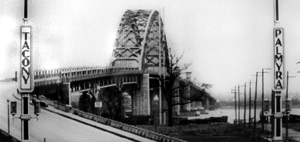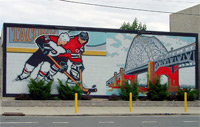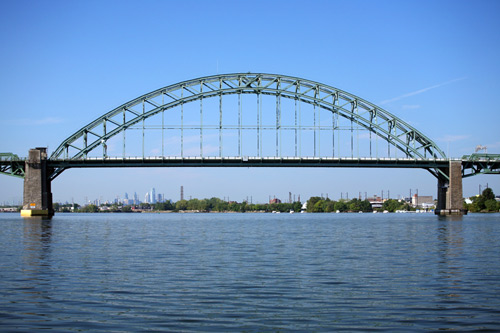|
|
|
19 September 08: And now, Tacony-Palmyra

Time . . . keeps flowing like a river . . . on and on . . . to the seeeea.
Tell you what man, I'll be the first to admit that I am a damned fool to have thought that I could fit every subject on a Delaware River checklist that seems to
grow every day into one summer. The individual bridges alone are enormous projects (I never expected to get 1,200 words out of the two Burlington-Bristol
bridges), and
there's about a million other topics worth covering. The nip in the air the last few days (and the nip that will stay in the air over the next few days --
seriously, what an amazing forecast) indicates that summer is done with us. Time and the tidal Delaware wait for no man, after all.
But Philly Skyline's not quite done with the Delaware, though. We're Atlantic Ocean bound, so we'll cross these bridges, or at least pass under them, as we get to
them.
And what better bridge to continue that journey than the next one down the river, the first one in the city of Philadelphia heading downstream: the Tacony-Palmyra
Bridge.
 This historic photo, from the interpretive center at the Palmyra Cove Nature Park, shows the bridge as
it was when it opened in 1929. It doesn't look very different today, but I'll bet some art deco collector is drooling somewhere over those signs. The nature park
has several miles of hiking, including along the Delaware shoreline, where one can wade (or swim, if you're daring) and take in an unmatched view of the
bridge.
This historic photo, from the interpretive center at the Palmyra Cove Nature Park, shows the bridge as
it was when it opened in 1929. It doesn't look very different today, but I'll bet some art deco collector is drooling somewhere over those signs. The nature park
has several miles of hiking, including along the Delaware shoreline, where one can wade (or swim, if you're daring) and take in an unmatched view of the
bridge.
The Tacony-Palmyra Bridge is perhaps Philadelphia's first real benchmark in the recognition of automobile travel. It predates the Schuylkill Expressway, I-95
and the auto dependent suburbs they created. The Ben Franklin Bridge does that too, sure,
but its location and size indicate a greater need to bring central Philadelphia and Camden together. Eight miles upstream, Tacony-Palmyra was the first one
after that bridge opened, bringing together a bustling, industrial Tacony neighborhood with New Jersey and all shore points east.
The bridge, like many of the tidal Delaware bridges, replaced a ferry company at the same location. Interestingly, the bridge was planned to touch down in
Riverton, just upstream, but its residents protested and the Tacony-Palmyra Ferry effectively became the Tacony-Palmyra Bridge. The Palmyra ferry terminal, at the
foot of Cinnaminson Avenue, is now a community center with tennis courts and a swimming pool. On the PA side, the land on both sides of the bridge is currently
vacant, but the Delaware River City Corporation has planned Lardner's Point Park,
named for the water department's historic pumping station on the south side of the bridge.
The Tacony-Palmyra Ferry Company had been operating only seven years when it ran its last crossing on August 14, 1929, the day the bridge opened to much pomp and
circumstance. There was bunting, there were boats (one which brought Mayor Harry Mackey to the event -- Philly History has some great photos of this HERE), and there were cars revved up and raring to go. And go they did. Thousands of people crossed the bridge on its opening day -- during
which access was free -- because they could. Collection of the original 35¢ toll began at 12:30 that night, and 90 minutes later the first accident occurred.
Tacony Civic Association president Louis Iatarola wrote a great history of the bridge for the Tacony Historical Society HERE.
Tacony-Palmyra's design can be considered a result of the success of the Ben Franklin Bridge. The latter opened in 1926, the pride of its engineer Ralph Modjeski
and his consulting architect Paul Cret. Tacony-Palmyra was to be the first of several additional bridges erected across the Delaware based on the New Jersey Act
of 1925, and Modjeski's firm was chosen. Working again with Cret, Modjeski delivered the steel arch bridge in 1927, and construction began in 1928. Construction
lasted less than 18 months and was completed under budget.
 Tacony-Palmyra is also a working bridge. While the 173' arch is so iconic it's used by both Palmyra
borough and Tacony civic (logos at left), it has a drawbridge that is equally as important. The
double leaf bascule opens from two counterbalanced sides to allow passage of tall vessels up and down the river. As we mentioned with the
Burlington-Bristol, the bridge is manned 24/7, as the bridge must open when a ship comes, rush hour traffic or not. The drawbridge occurs in the span
immediately to the east of the arch span, giving the Tacony-Palmyra the slightly off-centered appearance it has if you look at it from mid-river.
Tacony-Palmyra is also a working bridge. While the 173' arch is so iconic it's used by both Palmyra
borough and Tacony civic (logos at left), it has a drawbridge that is equally as important. The
double leaf bascule opens from two counterbalanced sides to allow passage of tall vessels up and down the river. As we mentioned with the
Burlington-Bristol, the bridge is manned 24/7, as the bridge must open when a ship comes, rush hour traffic or not. The drawbridge occurs in the span
immediately to the east of the arch span, giving the Tacony-Palmyra the slightly off-centered appearance it has if you look at it from mid-river.
 The name "Tacony-Palmyra" is nearly as adopted as the arch of the bridge (seen here in a mural depicting, appropriately, a hockey game between the Flyers and
Devils, and also in the arch at Tacony Billiards). The Tacony-Palmyra Drive-In, which opened in 1957
and closed in 1986, made its way back into the news earlier this year. Now the site of the Tacony-Palmyra Flea Market, Palmyra borough initiated a cleanup of the
60 acre site in anticipation of redevelopment. Imagine their surprise when they discovered 180 live shells left over by the US Army, which had a proving ground
here during World War II. Sam Wood wrote a great article for the Inquirer in April, HERE. The shells have been removed, and the flea market reopened in August.
The name "Tacony-Palmyra" is nearly as adopted as the arch of the bridge (seen here in a mural depicting, appropriately, a hockey game between the Flyers and
Devils, and also in the arch at Tacony Billiards). The Tacony-Palmyra Drive-In, which opened in 1957
and closed in 1986, made its way back into the news earlier this year. Now the site of the Tacony-Palmyra Flea Market, Palmyra borough initiated a cleanup of the
60 acre site in anticipation of redevelopment. Imagine their surprise when they discovered 180 live shells left over by the US Army, which had a proving ground
here during World War II. Sam Wood wrote a great article for the Inquirer in April, HERE. The shells have been removed, and the flea market reopened in August.
The bridge itself, despite carrying the smallest capacity -- three lanes -- of the four vehicular Delaware bridges in Philadelphia, is still well used, more so
since DRPA raised the tolls on the nearby Betsy Ross and Ben Franklin Bridges. Operated by the Burlington County Bridge Commission (BCBC), Tacony-Palmyra has a $2 toll, half
that of DRPA's bridges. As mentioned above, the original toll was 35¢, but that actually dropped twice, first in 1948 to 25¢, when the bridge was
purchased from the Tacony-Palmyra Bridge Company by the BCBC, and again to 5¢ in 1955 when the bonds were paid off. This earned the bridge the nickname the
"Nickel Bridge".
That same year, according to Steve Anderson's PhillyRoads.com, the Army Corps
of Engineers declared the bridge "'obsolete' and a hazard for navigation" with a recommendation for replacing it with a high-level bridge (i.e. one without a
drawbridge, so as to not impede vehicular or river traffic). That didn't happen, but BCBC did raise the tolls to begin necessary improvements.
In 1928, the last full year of the Tacony-Palmyra Ferry, it carried 508,000 passengers. The first full year of the Tacony-Palmyra Bridge saw 1.2 million
passengers. Nowadays, it averages a whopping 26 million a year. (Iatarola.)
All this even without an interchange with I-95, which came through nearly 40 years after the bridge's construction and whose closest exits are over a mile in
either direction.
Interestingly, in light of last year's bridge collapse in Minneapolis, the US Department of Transportation's National Bridge Inventory grabbed the attention of many governors and media outlets. Tacony-Palmyra was rated as structurally deficient. The
engineer Modjeski declared at the 1929 opening, "This is a bridge, with proper maintenance, that we hope will last one-hundred years." (This passage is from a
story called Bridge Lessons, by Harry Silcox and Jack McCarthy for the Northeast Times, online HERE.) We're eighty years out now, but in spite of the 'structurally deficient' tag, BCBC's maintenance ensures that the last 20 shouldn't be
a problem to meet Modjeski's prediction.
For a new mini-essay of photos of the Tacony-Palmyra Bridge (24 total), please click
HERE.

–B Love
|
SUMMER OF THE DELAWARE ARCHIVES:
|
|